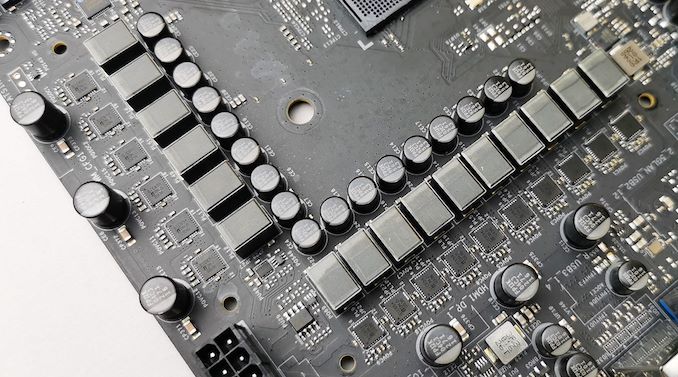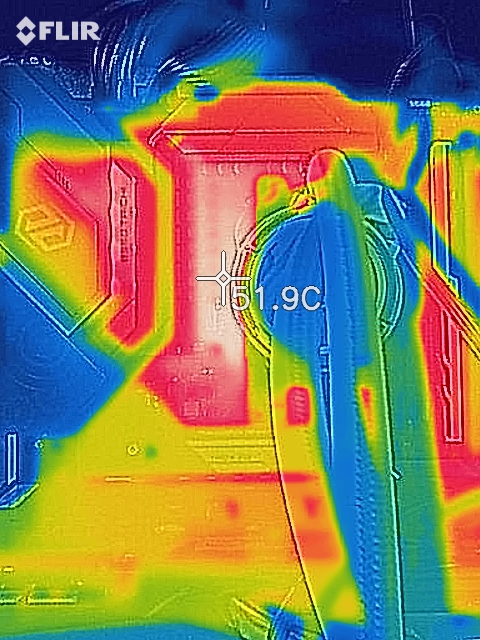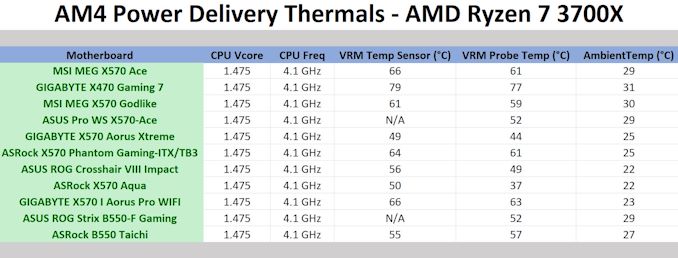ASRock B550 Taichi Review: The $300 B550 Motherboard with Chutzpah
by Gavin Bonshor on August 21, 2020 3:30 PM EST- Posted in
- Motherboards
- AMD
- ASRock
- Taichi
- AM4
- Ryzen 3000
- Ryzen 3700X
- Ryzen 4000
- B550
- B550 Taichi
Power Delivery Thermal Analysis
One of the most requested elements of our motherboard reviews revolves around the power delivery and its componentry. Aside from the quality of the components and its capability for overclocking to push out higher clock speeds which in turn improves performance, is the thermal capability of the cooling solutions implemented by manufacturers. While almost always fine for users running processors at default settings, the cooling capability of the VRMs isn't something that users should worry too much about, but for those looking to squeeze out extra performance from the CPU via overclocking, this puts extra pressure on the power delivery and in turn, generates extra heat. This is why more premium models often include heatsinks on its models with better cooling designs, heftier chunks of metal, and in some cases, even with water blocks.

The 16-phase power delivery operating at 7+1 on the ASRock B550 Taichi
Testing Methodology
Out method of testing out if the power delivery and its heatsink are effective at dissipating heat, is by running an intensely heavy CPU workload for a prolonged method of time. We apply an overclock which is deemed safe and at the maximum that the silicon on our AMD Ryzen 7 3700X processor allows. We then run the Prime95 with AVX2 enabled under a torture test for an hour at the maximum stable overclock we can which puts insane pressure on the processor. We collect our data via three different methods which include the following:
- Taking a thermal image from a birds-eye view after an hour with a Flir Pro thermal imaging camera
- Securing two probes on to the rear of the PCB, right underneath CPU VCore section of the power delivery for better parity in case the first probe reports a faulty reading
- Taking a reading of the VRM temperature from the sensor reading within the HWInfo monitoring application
The reason for using three different methods is that some sensors can read inaccurate temperatures, which can give very erratic results for users looking to gauge whether an overclock is too much pressure for the power delivery handle. With using a probe on the rear, it can also show the efficiency of the power stages and heatsinks as a wide margin between the probe and sensor temperature can show that the heatsink is dissipating heat and that the design is working, or that the internal sensor is massively wrong. To ensure our probe was accurate before testing, I binned 10 and selected the most accurate (within 1c of the actual temperature) for better parity in our testing.
For thermal image, we use a Flir One camera as it gives a good indication of where the heat is generated around the socket area, as some designs use different configurations and an evenly spread power delivery with good components will usually generate less heat. Manufacturers who use inefficient heatsinks and cheap out on power delivery components should run hotter than those who have invested. Of course, a $700 flagship motherboard is likely to outperform a cheaper $100 model under the same testing conditions, but it is still worth testing to see which vendors are doing things correctly.
Thermal Analysis Results

We measured 51.9°C on the hottest part of CPU socket area during our testing
The ASRock B550 Taichi is using a 16-phase design which is operating in a 7+1 configuration with an Intersil ISL229004 8-phase PWM controller. It is using fourteen Vishay SiC654 50 A power stages for the CPU and two SiC654 50 A power stages for the SoC. The CPU section is using seven ISL6617A doublers, while the SoC section is using a single ISL6617A doubler which makes the B550 Taichi's power delivery a 7+1 design. The power delivery is cooled by a pair of heatsinks connected by a single heat pipe which relies on passive airflow within a chassis.
In our power delivery thermal testing, the ASRock B550 Taichi performs quite well against other AM4 boards on test. Our testing shows that the Taichi's 16-phase design is rather efficient, which puts it ahead of some high-end X570 models which is impressive. The Taichi includes a dedicated temperature sensor for the power delivery which in our testing displayed a reading of 55°C, while our K-type probe mounted to the rear of the power delivery measured a reading of 57°C. Using our FLIR thermal imaging camera, we measured a 51.9°C on the hottest part of the CPU socket area, which shows that the cooling properties of the heatsink is efficient at dissipating heat. For a B550 motherboard, the results are competitive, and that the ASRock B550 Taichi is a very competent board for overclocking.











61 Comments
View All Comments
Marlin1975 - Friday, August 21, 2020 - link
But why? Just get a x570 board with more features.The b550 is supposed to be a cheaper board to the x570s.
29a - Friday, August 21, 2020 - link
I ask the same thing, why? Why didn't they just use the 570?peevee - Monday, August 24, 2020 - link
$300 board, why? I have bought $50 boards, and it was at the time when north bridge was still on a separate chip. Admittedly, my last build is from 2011... with 2600k... still works, only Ethernet has died (and was replaced with a cheap card, as it should have been).Samus - Friday, August 28, 2020 - link
Premium boards generally do pay off. Every premium board I've purchased lasted over a decade with 0 issues. Every cheap board I bought had at least 1 issue within a few years.Example: Asus P6X58D ($300 in 2008, retired LAST YEAR)
Example Asrock H87M-ITX ($120 in 2013, the cheapest H87 ITX board, retired 3 years later when it wouldn't POST half the time during a reboot\cold boot)
Gigaplex - Tuesday, August 25, 2020 - link
Where I live, the Gigabyte B550I Aorus Pro AX is 20% cheaper than the Gigabyte X570 I Pro Wifi, and includes 2.5Gbit ethernet which the X570 doesn't have. It's a no-brainer for me, B550 it is.desii - Friday, August 21, 2020 - link
>why?Chipset fan.
bananaforscale - Saturday, August 22, 2020 - link
Chipset fan, that1) doesn't even come on unless required and
2) is required only if you stress test PCIe 4 drives.
The fan is not an issue.
WaltC - Saturday, August 22, 2020 - link
Doesn't make any noise, either...;) The chipset fan nonsense has always been a red herring, imo.Spunjji - Monday, August 24, 2020 - link
I understood the trepidation from some people, but it's clear that most of it was FUD from Intel stans.TheinsanegamerN - Tuesday, August 25, 2020 - link
Not really nonsense when it's been demonstrated that 570 can easily be cooled by passive heatsinks and there is a very good reason people loathe those tiny fans. Tiny fans didnt become super reliable overnight.